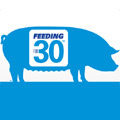 When it comes to litters, size matters. Larger numbers of pigs per litter have a direct correlation with an operation’s total pigs marketed; however, for these pigs to meet their full potential, adequate birth weights are necessary.
When it comes to litters, size matters. Larger numbers of pigs per litter have a direct correlation with an operation’s total pigs marketed; however, for these pigs to meet their full potential, adequate birth weights are necessary.
“No matter the genetics, the management or the facilities, birth weight plays a big factor in a pig’s lifetime productivity,” says Dr. Gawain Willis, director of nutrition services for Purina Animal Nutrition LLC.


Willis explains that measuring birth weights are especially important as current genetics are helping sows move towards larger litters. Unfortunately this trend is also resulting in a trend toward lower birth weights. In fact, research shows the average birth weight of each pig drops an average of 0.10 pound for each additional pig in the litter.
“As the industry evolves and larger litters become more common, producers must pay close attention to birth weights in their farrowing units,” he says.
Purina Animal Nutrition has evaluated birth weights at the Purina Animal Nutrition Center in Gray Summit, Mo., for several years. Along with Brenda De Rodas, director of swine research with Purina Animal Nutrition, Willis measured birth weights on 2,456 litters over a 5-year timespan. The two found that a 1-pound difference in birth weight (3.1 pounds versus 2.1 pounds) resulted in twice the survival rate from birth to weaning.
“Birth weights played a significant role in pre-weaning mortality rates,” Willis says. “Almost all of our pre-weaning mortality occurred in the smaller birth weights. Growth rates, feed efficiency and piglet vitality were also noticeably improved with higher birth weights.”
Heavier-born pigs were able to get off to a proper start and also reached weaning and market weights quicker; with 2.8 pounds higher weaning weights. When looking at the timeline to finishing, pigs born between 3.1 and 3.5 pounds reached the marketable weight of 270 pounds, 7 days sooner than pigs with birth weights of 1.6 to 2 pounds.
Increased nutrients through gestation and lactation are one major factor required to allow sows to produce these heavier litters. Willis explains that higher-producing sows require increased nutrients to achieve long-term production or they may fall out of the herd too soon.
If the nutritional needs of the sow aren’t met, the potential remains for low birth weights.
“Failing to feed sows for increased productivity can also lead to rebreeding problems and high sow culling rates,” Willis says. “But feeding them properly can result in greater efficiency for both the piglets and the sows. Lifetime productivity of sows and the pigs they produce begins with feeding the sows the quality and quantity of nutrients they require.”
For more information, contact Gawain Willis at (636) 742-6154 or email: gmwillis@landolakes.com. Swine producers, veterinarians and nutritionists can learn more about the Feeding for 30TM Program and access nutritional resources by visiting www.Feedingfor30.com or www.facebook.com/Feedingfor30.
Purina Animal Nutrition LLC (www.purinamills.com) is a national organization serving producers, animal owners and their families through more than 4,700 local cooperatives, independent dealers and other large retailers across the United States. Driven by an uncompromising commitment to animal excellence, Purina Animal Nutrition is an industry innovator, offering America's leading brands of complete feeds, supplements, premixes, ingredients and specialty technologies for the livestock and lifestyle animal markets. Headquartered in Shoreview, Minn., Purina Animal Nutrition LLC is a wholly owned subsidiary of Land O’Lakes, Inc.
Because of factors outside of Purina Animal Nutrition LLC’s control, individual results to be obtained, including but not limited to: financial performance, animal condition, health or performance cannot be predicted or guaranteed by Purina Animal Nutrition LLC.

January 18, 2013 - Purina Animal Nutrition LLC


